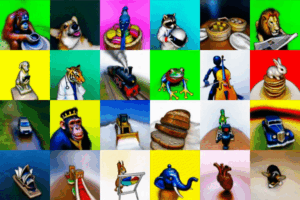SNL Creative is testing new workflows to use AI programs like Dream Fusion, DALL-E 2D, Stable Diffusion, and Point-E are all AI-based image processing algorithms in beta or under development to convert 2D images into 3D models.

The process of converting 2D images into 3D geometry using AI is a relatively new field of research that has seen significant advancements in recent years. 3D rendering when was developed two years ago by using the power of neural networks to provide a photorealistic experience far superior to other technologies at that time, as stated in [1].
The problem of converting a 2D image to its original 3D scene is known as inverse graphics, which is challenging due to the relationship between 2D images and 3D shapes. However, with the advancements in AI, deep learning, and computer vision techniques, converting 2D images into 3D geometry is becoming more accurate, efficient, and cost-effective.
DreamFusion is an AI tool developed by researchers from Google that automatically transforms text prompts into full 3D models. It is an extension of software developed to perform text-to-image, which can generate detailed and realistic images from short descriptor sentences called prompts. DreamFusion is an expanded version of Dream Fields, a generative 3D system Google unveiled in 2021
DALL-E 2D is an AI-based system developed by OpenAI that can generate 3D models from 2D images. It uses a modified GLIDE model that incorporates projected CLIP text embeddings in two ways: by adding the CLIP text embeddings to GLIDE’s existing timestep embedding, and by creating four extra tokens of context, which are concatenated to the output sequence of the GLIDE text encoder. By using several million 3D objects and associated metadata. The model was trained with images and associated 3D objects, learning to generate corresponding point clouds from images. The system can be used to create 3D models directly from 2D images with minimal human intervention
Stable Diffusion is an algorithm that uses a generative model to convert 2D images into 3D models. The algorithm uses a combination of deep learning and computer vision techniques to analyze the image and create a 3D representation of the object. The algorithm is based on the idea of “diffusion,” which refers to the process of spreading information through a network.
Point E is a machine learning system that creates 3D models from text prompts. It works in two parts: first, it uses a text-to-image AI to convert a worded prompt into an image, then it uses a second function to turn that image into a 3D model. According to a paper published by the OpenAI team, Point-E can produce 3D models in minutes. The system was open sourced by OpenAI in December 2022, and it aims to provide a quick and efficient way to generate 3D models from text inputs. [1], [2], [3]
It’s worth noting that the quality and accuracy of the generated models heavily depend on the complexity of the input text, the quality of the training dataset, and the specific architecture and parameters used in the algorithm, so the output models might not be suitable for all use cases.
All four algorithms are in beta or still under development and research, but they show promising results in converting 2D images into 3D models. They can help automate the process of creating 3D models, making them faster, more accurate, and cost-effective, which can have applications in various industries such as gaming, animation, and architectural visualization.
Volumetric Neural Radiance Field (NeRF) [2]data is a type of 3D representation of an object or scene that is generated using a deep learning algorithm called Neural Radiance Field (NeRF). It is a volumetric representation, which means that it represents the object or scene as a 3D grid of voxels (3D pixels) rather than a surface mesh.
A NeRF model is trained on a dataset of 2D images and corresponding 3D models, and it learns to understand the relationship between the 2D image and the 3D shape. Once trained, the model can generate a 3D representation of an object or scene by analyzing a 2D image. The generated word is a continuous function that maps each point in 3D space to a feature vector describing the properties of the scene at that point.
Volumetric NeRF data can generate 3D models of objects or scenes with great detail and accuracy, even when the input images are taken from different viewpoints. This makes it useful for 3D reconstruction, virtual reality, and augmented reality applications.
One of the critical features of volumetric NeRF data is that it can be rendered from any viewpoint, unlike traditional surface-based 3D models, which can only be generated from a limited set of views. This allows for more flexibility and realism in 3D visualizations.
It’s worth noting that the quality and accuracy of the generated models heavily depend on the input images’ complexity, the training dataset’s quality, and the specific architecture and parameters used in the algorithm, so the output models might not be suitable for all use cases.

Neural 3D Mesh Renderer (N3MR) [3]of high-quality 3D textured shapes learned from images are a class of AI-based algorithms that use deep learning to generate 3D models from 2D images. They are designed to create highly detailed and accurate 3D models with realistic textures and lighting effects.
These models are trained on large datasets of 2D images and corresponding 3D models, and they learn to understand the relationship between the 2D image and the 3D shape. The models can then generate 3D models from new 2D photos by analyzing the image and creating a 3D representation of the object based on the learned relationship.
One example of this technology is “Neural 3D Mesh Renderer (N3MR),” a neural network-based algorithm that combines deep learning and computer vision techniques to generate 3D models from 2D images. It can develop high-quality 3D models of objects with realistic textures and lighting effects by learning the relationship between the 2D image and the 3D shape from a dataset of 2D pictures and 3D models.
This technology can have various applications in different industries, such as gaming, animation, and architectural visualization. It can help automate the creation of 3D models, making them faster, more accurate, and cost-effective. With the advancements in deep learning and computer vision techniques, the quality of the generated models is also increasing, making them more suitable for realistic rendering and visualization.
The accuracy of the generated models heavily depends on the input images’ complexity, the training dataset’s quality, and the specific architecture and parameters used in the algorithm, so the output models might only be suitable for some use cases.

Photogrammetry [4], The process of converting 2D images into 3D models is typically achieved through photogrammetry. Photogrammetry is a method of using photographs to measure and generate 3D models. The process involves taking multiple pictures of an object from different angles and using specialized software to analyze and process these images. The software then creates a 3D model by merging the additional photos, using the overlapping information to create depth and form.
The process of photogrammetry is divided into two main steps: image acquisition and image processing.
- Image Acquisition: This step involves taking multiple photographs of an object from different angles. A high-resolution camera and a tripod are often used to ensure that the images are clear and stable. The photos should also be taken under consistent lighting conditions to minimize shadows and distortions.
- Image Processing: This step is performed using specialized software, such as Agisoft Photoscan, Autodesk ReMake, or RealityCapture. The software uses algorithms to analyze and process the images, creating a 3D model by merging the different pictures. The software also generates a texture map, which can be used to add color and other details to the 3D model.
The resulting 3D model can then be exported as a file format that a 3D printer can read, such as STL, OBJ, or VRML. The model can be printed using any 3D printing technology or base models for class A modeling packages.
this process is not fully automated and requires manual adjustments, such as setting the correct parameters and adjusting the model after the initial processing. But with the advancements in AI and deep learning, this process is becoming increasingly automated, where AI-based algorithms can generate 3D models directly from images with minimal human intervention.

Furthermore, it is also essential to consider the ethical implications of AI-generated 3D models, such as potential copyright infringement, as AI models can borrow heavily from the training data.
In conclusion, AI-generated 3D models have the potential to revolutionize various industries and make the process of creating 3D models more efficient and cost-effective. However, it’s essential to consider the limitations and ethical implications of this technology.
